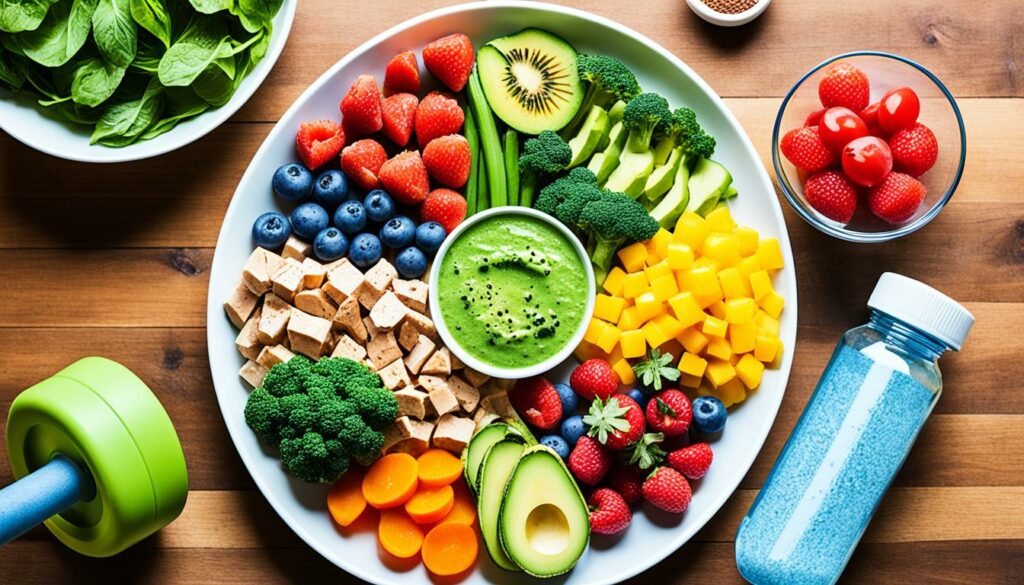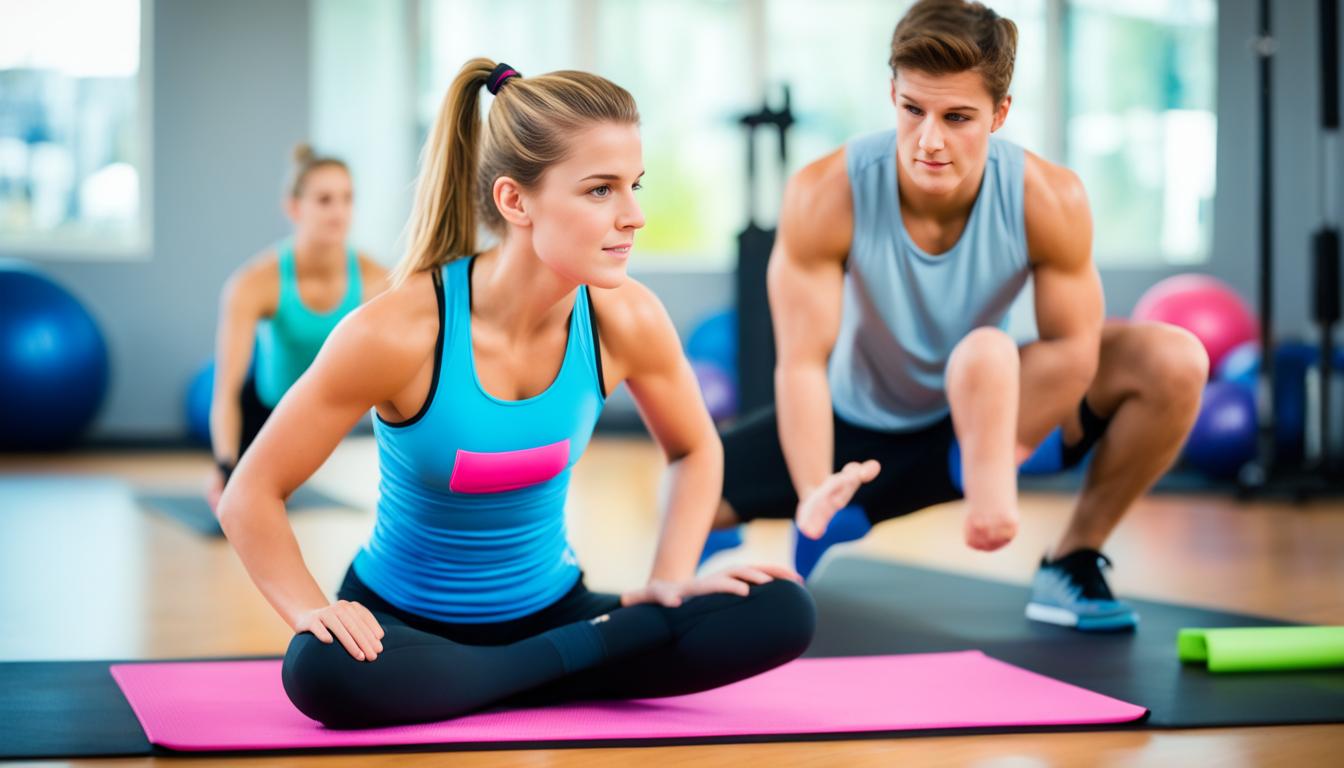Teen Abs 101: How to Get Abs for Teens Safely
Are you a teenager looking to develop strong and defined abs? You’ve come to the right place! In this article, we will provide you with valuable tips, exercises, and expert guidance on how to get abs as a teenager safely and effectively.
Getting abs as a teenager requires a combination of proper nutrition and targeted exercises. We understand that your body is still developing, so it’s essential to approach abs development with caution and prioritize your overall health and well-being.
Throughout this article, we will cover the best exercises for teenager abs, provide valuable teenage fitness tips, and guide you on how to achieve visible abs during your teenage years. Remember, it’s not just about getting a six-pack, but about building a strong and healthy core for a lifetime.
Key Takeaways:
- Proper nutrition and targeted exercises are key to developing abs as a teenager.
- Focus on overall health and well-being throughout the process.
- Incorporate core-strengthening exercises specifically designed for teens.
- Combine ab workouts with cardiovascular exercises to burn fat and reveal abs.
- Set realistic goals, be patient, and avoid comparing yourself to unrealistic body standards.
Abdominal Exercises for Teens

Developing strong abdominal muscles and core strength is essential for teens who want to achieve defined abs. Incorporating the right exercises into your workout routine can help you reach your goals. Here are some effective abdominal exercises specifically designed for teens:
1. Basic Crunches
One of the most common exercises for targeting the abdominal muscles is the basic crunch. Lie flat on your back with your knees bent and feet flat on the floor. Place your hands behind your head, keeping your elbows out to the sides. Lift your upper body off the floor by contracting your abdominal muscles and exhale as you crunch. Lower your body back down to the starting position and repeat.
2. Reverse Crunches
Reverse crunches target the lower abdominal muscles. Lie flat on the floor with your hands by your sides. Lift your legs off the floor and bring your knees towards your chest. Use your abdominal muscles to lift your hips off the floor, curling the knees towards your head. Slowly lower your legs back down and repeat the movement.
3. Bicycle Crunches
Bicycle crunches engage the entire core, including the obliques. Lie flat on your back with your hands behind your head. Lift your shoulder blades off the floor and bring your right elbow towards your left knee while straightening your right leg. Repeat on the other side, bringing your left elbow towards your right knee. Continue alternating sides in a pedaling motion.
4. Overhead Crunches
Overhead crunches target both the upper and lower abdominal muscles. Lie on your back with your legs bent and your feet flat on the floor. Extend your arms straight above your head. Lift your shoulder blades off the floor and simultaneously bring your knees towards your chest. Exhale as you crunch, then lower your upper body and legs back down to the starting position.
Perform each exercise with proper form and technique to maximize results. Start with a moderate number of repetitions and gradually increase as your core strength improves. Always listen to your body and avoid any exercises that cause pain or discomfort. Remember to maintain proper breathing throughout each exercise.
| Exercise | Description |
|---|---|
| Basic Crunches | Lie on your back with knees bent and feet flat on the floor. Place your hands behind your head. Lift your upper body off the floor, exhaling as you crunch. Lower back down and repeat. |
| Reverse Crunches | Lie on your back with hands by your sides. Lift your legs off the floor and bring your knees towards your chest. Use your abdominal muscles to lift your hips off the floor, then lower back down and repeat. |
| Bicycle Crunches | Lie on your back with hands behind your head. Lift your shoulder blades off the floor. Bring your right elbow towards your left knee while straightening your right leg. Repeat on the other side in a pedaling motion. |
| Overhead Crunches | Lie on your back with legs bent and feet flat on the floor. Extend your arms straight above your head. Lift your shoulder blades off the floor while bringing your knees towards your chest. Lower back down and repeat. |
The Importance of Proper Technique and Form

When it comes to ab exercises, proper technique and form are essential for both injury prevention and achieving optimal results. Focusing on maintaining correct posture, alignment, and breathing throughout each exercise will ensure that the targeted muscles are engaged effectively. Here are some tips to help you perform teen abs exercises with proper technique:
- Start by finding a comfortable and stable position. This may include lying on your back or supporting your body weight on your forearms and toes for planks.
- Keep your back straight and avoid arching or rounding your spine. Engage your core muscles to stabilize your spine throughout the exercise.
- Pay attention to your breathing. Exhale as you contract your abs, and inhale as you release the contraction.
- Avoid straining your neck or using your hands to pull on your head during abdominal exercises. Instead, focus on using your core muscles to lift your shoulders off the ground or bring your knees towards your chest.
- Perform each movement in a slow and controlled manner, avoiding any jerking or swinging motions. This will ensure that you are specifically targeting the abdominal muscles.
The Benefits of Proper Technique and Form
By practicing proper technique and form, you can maximize the effectiveness of your teen abs exercises. Not only will this help you develop stronger and more defined abs, but it will also reduce the risk of injury. Proper technique allows for better muscle activation and engagement, targeting the intended muscles while minimizing strain on other parts of the body.
Additionally, maintaining correct posture and alignment during core exercises can have a positive impact on your overall posture and stability. It can help strengthen the muscles that support your spine and improve your body’s ability to maintain a neutral spine position in everyday activities.
Remember, it’s always a good idea to consult with a qualified fitness professional or trainer to ensure that you are performing exercises with proper technique and form.
“Proper form is crucial for getting the most out of your teen abs workouts. It’s not about how many repetitions you do, but rather how well you execute each movement.” – Fitness Expert
Incorporating Plank Exercises
Plank exercises are a fantastic way for teens to engage their entire core, including the abs, obliques, and lower back. Not only do they help strengthen and tone the abdominal muscles, but they also promote stability and improve posture.
To perform a basic plank, follow these steps:
- Start by positioning yourself face down on the floor, supporting your body weight on your forearms and the balls of your feet.
- Make sure your elbows are directly beneath your shoulders and your body forms a straight line from head to heels.
- Engage your core muscles by drawing your belly button in towards your spine.
- Maintain this position for as long as you can while keeping proper form.
To challenge yourself and add variation to your plank workout, try these modifications:
- Side planks: Instead of supporting your body weight on your forearms, extend your arms fully and turn to one side, resting on one forearm and the side of your foot. Hold the position for as long as you can, then switch sides.
- Extended planks: Begin in a standard plank position, then extend one arm straight out in front of you while keeping your balance. Hold for a few seconds, then switch arms.
Remember, it’s important to maintain proper technique and form throughout each variation. Focus on engaging your core muscles, keeping your body aligned, and breathing steadily. Start with shorter durations and gradually increase both the difficulty and duration of your plank exercises as your strength improves.
Balancing Ab Workouts with Cardiovascular Exercise

To see the results of their hard work, teens need to combine ab workouts with cardiovascular exercise to burn fat and reveal their abdominal muscles. Cardio exercises not only help in burning belly fat but also improve overall fitness and cardiovascular health. By incorporating cardio into their fitness routine, teens can achieve a leaner physique and strengthen their abdominal muscles.
Here are some cardio exercises that are suitable and effective for teenagers:
- Jogging: A great way to get your heart rate up and burn calories. Start with a brisk walk and gradually increase the intensity to a jog.
- Sprinting: Intense bursts of speed can significantly raise your heart rate and burn fat.
- Swimming: A low-impact, full-body workout that not only strengthens your abs but also works other muscle groups.
- Biking: Riding a bicycle is a fun and effective way to engage your core muscles while getting an excellent cardiovascular workout.
- Jumping Jacks: This classic exercise not only increases your heart rate but also engages your abs and other muscle groups.
- Jump Rope: Jumping rope is a challenging and calorie-burning exercise that targets your abs, arms, and legs.
Remember, it’s essential to choose cardio exercises that you enjoy and can sustain for longer durations. Aim for at least 30 minutes of moderate to vigorous cardio exercise on most days of the week to reap the maximum benefits.
Now, let’s take a closer look at how combining cardio with abs workouts can help in achieving your fitness goals:
“Cardiovascular exercise helps burn calories and reduce overall body fat, including belly fat. By combining cardio with targeted ab exercises, you can enhance the fat-burning process and increase definition in your abdominal muscles.”
When performing cardio exercises, the key is to maintain an elevated heart rate for an extended period. This will stimulate fat burning and increase your overall calorie expenditure. As you shed excess body fat, your abdominal muscles will become more visible and defined.
For optimal results, consider incorporating cardio exercises into your workout routine at least three to four times a week. However, be mindful not to overdo it. Gradually increase the intensity and duration of your cardio workouts to avoid overtraining and injuries.
By striking a balance between ab workouts and cardiovascular exercise, teens can create a comprehensive fitness routine that promotes fat loss and strengthens their core muscles. It’s important to remember that consistency, proper form, and a healthy diet are key factors in achieving and maintaining a lean and toned physique.
The Role of Nutrition in Teen Abs Development

Good nutrition plays a vital role in developing abs as a teenager. It’s essential to prioritize healthy eating to support muscle development and overall fitness. Incorporating nutrient-rich foods into a teen’s diet can provide the necessary fuel for building strong and defined abdominal muscles.
Protein for Muscle Development
Protein is a crucial nutrient for muscle development. It provides the building blocks needed for repairing and strengthening muscles, including the abdominal muscles. Incorporating protein-rich foods into a teen’s diet can help support their abs development goals.
- Poultry: Lean chicken or turkey breasts are excellent sources of high-quality protein. They can be grilled, baked, or sautéed for a healthy and delicious meal.
- Fish: Fatty fish like salmon, mackerel, and tuna are packed with omega-3 fatty acids and protein. They are not only beneficial for muscle development but also support heart health.
- Legumes: Foods like beans, lentils, and chickpeas are excellent plant-based sources of protein. They are also rich in fiber, which aids digestion and promotes overall well-being.
- Nuts: Almonds, walnuts, and cashews are not only a great source of protein but also provide healthy fats and other essential nutrients. They can be a convenient and satisfying snack option.
- Eggs: Eggs are a complete protein source and can be prepared in various ways, such as hard-boiled, scrambled, or in omelets.
- Full-fat Dairy: Options like Greek yogurt, cottage cheese, and milk provide protein while also offering calcium and other essential nutrients.
Healthy Eating for Teenagers
A healthy diet consists of more than just protein. It’s important to focus on whole foods, complex carbohydrates, and fiber to support overall health and optimal abs development.
- Whole Foods: Opt for whole grains like brown rice, quinoa, and oats instead of refined grains. Whole foods provide more nutrients and fiber, keeping you fuller for longer.
- Complex Carbohydrates: Incorporate complex carbohydrates like sweet potatoes, whole fruits, and vegetables into meals. They provide sustained energy and essential nutrients.
- Fiber: Adequate fiber intake is essential for healthy digestion and overall well-being. Include foods like leafy greens, berries, and beans to ensure a fiber-rich diet.
- Reducing Added Sugar: Limiting added sugar is important for maintaining a healthy weight and overall well-being. Choose natural sugars found in fruits and minimize sugary drinks and processed treats.
“Good nutrition is the foundation for developing strong abs and maintaining a healthy body. By fueling your body with the right foods, you can optimize your workout results and achieve the abs you desire.” – Jennifer Roberts, Registered Dietitian
Remember, while nutrition plays a significant role in abs development, it’s important to maintain a balanced approach. Combine a healthy diet with targeted exercises and a positive mindset to achieve optimal results. Stay consistent, enjoy the journey, and celebrate each step towards a stronger and healthier you!
Setting Realistic Goals and Frequency of Workouts
When it comes to developing abs as a teenager, setting realistic goals and establishing a suitable workout frequency are key. It’s important to remember that achieving visible abs takes time and dedication. By setting realistic expectations, you can set yourself up for success and avoid unnecessary disappointment.
Setting Goals for Teen Abs
Setting goals is an essential part of any fitness journey. However, it’s crucial to set goals that are achievable and aligned with your individual capabilities and body type. Keep in mind that genetics also play a role in the visibility of your abs.
Instead of solely focusing on achieving a specific look, consider setting goals that are centered around performance and overall strength improvement. This way, you can measure your progress based on personal records and milestones, leading to a more fulfilling journey.
The Recommended Workout Frequency
Consistency is key when it comes to developing abs. While it may be tempting to perform intense ab workouts every day, it’s important to allow your muscles time to rest and recover.
Aim to incorporate targeted abdominal exercises into your routine 2-3 times a week, allowing at least one day of rest between sessions. This will give your muscles ample time to rebuild and grow stronger. It’s also beneficial to include full-body workouts and cardiovascular exercises on alternate days to promote overall fitness and fat burning.
To optimize your progress, gradually increase the intensity and duration of your workouts over time. Start with a manageable workload and incrementally challenge yourself as your strength and endurance improve.
| Workout Frequency | Recommended |
|---|---|
| Abdominal Exercises per Week | 2-3 times |
| Rest Days Between Ab Workouts | at least 1 day |
Remember, quality over quantity is essential. Focus on performing each exercise with proper form and control rather than rushing through repetitions. As you progress, you can gradually increase the number of sets and reps to challenge your muscles further.
Quote:
“Setting realistic goals and maintaining a consistent workout frequency is the key to achieving long-lasting results in teen abs development.” – Fitness Expert
By setting realistic goals and following a suitable workout frequency, you can safely and effectively work towards developing strong and defined abs as a teenager. Stay committed, listen to your body, and enjoy the journey to a healthier and fitter you!
The Time Frame for Seeing Results
When it comes to developing visible abs as a teenager, the timeline for seeing results can vary. It is important to remember that individual factors such as starting body fat percentage and genetics can influence the time it takes to achieve visible abs. However, with dedication, patience, and consistency, it is possible to see progress over time.
Body fat percentage plays a significant role in the visibility of abdominal muscles. Generally, a lower body fat percentage is necessary to make abs more visible. For teenage boys, a body fat percentage of approximately 10-12% is often considered a benchmark for visible abs. For teenage girls, a body fat percentage of around 15-18% is typically required.
With consistent effort, including a combination of targeted exercises and a balanced diet, it is possible to achieve visible abs in as little as a few months for some individuals. However, it is important to note that this is not a universal timeframe and may vary depending on multiple factors including starting body fat percentage, genetics, and adherence to fitness and nutrition programs.
Here is a general timeline for achieving visible abs based on body fat percentage:
| Body Fat Percentage | Estimated Time Frame for Visible Abs |
|---|---|
| Boys: 12-14% | Girls: 18-20% | Around 6-8 months |
| Boys: 10-12% | Girls: 15-18% | Around 3-6 months |
| Boys: 8-10% | Girls: 12-15% | Around 1-3 months |
It is important to note that these time frames are estimates and can vary depending on various factors. It is crucial to approach your fitness journey with a focus on long-term health and progress rather than obsessing over a specific time frame.
Remember, consistency and adherence to a balanced exercise routine and nutrition plan are key to achieving visible abs. Stay committed, be patient, and celebrate your progress along the way!
Maintaining a Healthy Mindset and Body Image
The Importance of a Healthy Mindset
Developing abs as a teenager goes beyond physical fitness; it also involves nurturing a healthy mindset. Focusing on overall well-being, self-acceptance, and avoiding comparisons with unrealistic body standards is essential for long-term success. By cultivating a positive mindset, teens can prioritize their mental and emotional health alongside their physical fitness goals.
Emphasizing Self-Confidence and Body Image
Building self-confidence is key to achieving any fitness goal, including abs development. Encouraging teens to appreciate their bodies for their strength and functionality rather than solely for their appearance can foster a healthier body image. By shifting the focus from external validation to self-acceptance, teenagers can develop a more positive relationship with their bodies and enjoy the journey towards abs development.
Tips for Building Self-Confidence
- Focus on achievements beyond physical appearance, such as increased strength or improved endurance.
- Practice positive self-talk and affirmations to boost self-confidence and reinforce a healthy body image.
- Engage in activities outside of fitness that bring joy and fulfillment, helping to develop a well-rounded sense of self-worth.
- Surround oneself with supportive and positive influences, such as friends, family, and mentors.
- Set realistic goals and celebrate progress, recognizing that everyone’s fitness journey is unique.
Developing a Healthy Relationship with Exercise and Nutrition
Encouraging a healthy mindset also involves establishing a balanced approach to exercise and nutrition. Teenagers should view exercise as a way to promote overall wellness rather than solely for physical appearance. Similarly, emphasizing the importance of nourishing the body with wholesome foods for energy and vitality can contribute to a positive mindset surrounding nutrition.
Image:
| Benefits of a Healthy Mindset | Strategies for Developing a Healthy Mindset |
|---|---|
| Enhanced self-confidence and self-esteem | Practice self-care activities: meditation, journaling, or engaging in hobbies |
| Reduced stress and anxiety | Surround oneself with positive role models and supportive communities |
| Improved motivation and adherence to fitness goals | Set realistic and achievable goals to boost motivation |
| Greater resilience and ability to overcome challenges | Seek guidance from trusted fitness professionals or mentors |
Staying Safe and Avoiding Injury
Safety should always be the top priority when performing ab exercises, especially for teenagers. By following these safety tips, you can prevent injuries and ensure a safe and effective workout:
- Warm up: Prior to starting any ab workout, it’s crucial to warm up your body. This helps increase blood flow to your muscles, preparing them for exercise and reducing the risk of injury.
- Cool down: After completing your ab workout, make sure to cool down by stretching your abdominal muscles. This will help prevent muscle soreness and promote flexibility.
- Avoid excessive weight or resistance: It’s important to start with a weight or resistance level that is appropriate for your fitness level. Gradually increase the intensity as your strength improves to avoid overloading your muscles and risking injury.
- Listen to your body’s limits: Pay attention to any pain or discomfort during your ab exercises. If you feel any strain or excessive muscle fatigue, reduce the intensity or take a break. Pushing through pain can lead to injury.
Remember, it’s always better to start with lighter exercises and gradually progress in difficulty rather than rushing into advanced movements that your body is not yet ready for. By exercising caution and prioritizing safety, you can prevent injuries and enjoy a safe and effective ab workout routine.
Safety Quote:
“Safety first! Prioritizing safety during ab workouts is the key to long-term progress and injury prevention.” – Fitness Expert
Conclusion
In conclusion, the journey to developing abs as a teenager is a combination of proper nutrition, targeted exercises, and a healthy mindset. Throughout this article, we have provided a comprehensive guide to help teens safely and effectively develop strong and defined abdominal muscles.
Remember, achieving teen abs requires patience and consistency. It’s important to prioritize overall health and well-being rather than solely focusing on the appearance of a six-pack. By following a balanced nutrition plan and incorporating the recommended exercises, teens can build a strong core and enhance their overall fitness.
Keep in mind that everyone’s body is unique, and the timeline for visible abs can vary. It’s crucial to set realistic goals and maintain a positive body image throughout the journey. Remember that abs are not the sole indicator of health or fitness, and it’s essential to embrace self-acceptance and avoid comparing oneself to unrealistic body standards.
By staying safe, following proper technique and form, and listening to your body, teens can achieve their desired fitness goals. Remember that the process of developing abs as a teenager is a long-term commitment, and the key to success lies in consistency, perseverance, and prioritizing overall well-being.
FAQ
What exercises can teens do to develop abs?
Teens can perform exercises like crunches, reverse crunches, bicycle crunches, and overhead crunches to target the abdominal muscles and develop core strength.
How important is proper technique and form when doing ab exercises?
Proper technique and form are crucial for preventing injury and maximizing the effectiveness of ab exercises. Maintaining proper posture, alignment, and breathing is essential for optimal results.
What are some variations of plank exercises that teens can do?
Teens can try variations such as side planks and extended planks to engage the entire core, including the abs, obliques, and lower back.
What are some suitable cardio exercises for teens?
Teens can try jogging, sprinting, swimming, biking, jumping jacks, and jump rope as cardio exercises to burn fat and reveal their abdominal muscles.
How does nutrition play a role in developing abs as a teenager?
Good nutrition is important for developing abs as a teenager. Teens should incorporate protein-rich foods, whole foods, complex carbs, and fiber into their diet while reducing added sugar.
What is the recommended frequency of ab workouts for teens?
Teens should set realistic goals and avoid overtraining. Gradually increasing intensity and progressing with exercises is encouraged to prevent injury and achieve optimal results.
How long does it take to see visible abs as a teenager?
The timeline for seeing visible abs as a teenager varies depending on the starting body fat percentage. Consistency and patience are key factors in achieving visible abs.
How can teens develop a healthy mindset and positive body image while working towards abs?
Teens should focus on overall health, self-acceptance, and avoiding comparisons with unrealistic body standards. Building self-confidence and developing a healthy relationship with exercise and nutrition are crucial.
What safety tips should teens keep in mind during ab workouts?
Teens should warm up and cool down, avoid excessive weight or resistance, and listen to their body’s limits. It is important to pause workouts if muscles are sore or strained to prevent injuries.







